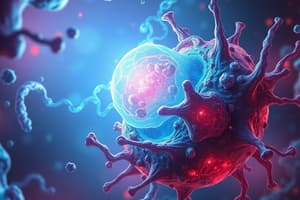Podcast
Questions and Answers
Which organ shows left ventricular hypertrophy as a form of adaptation?
Which organ shows left ventricular hypertrophy as a form of adaptation?
- Liver
- Kidneys
- Brain
- Heart (correct)
What is the primary characteristic of atrophy?
What is the primary characteristic of atrophy?
- Increased cell size
- Increased residual bodies
- Increased autophagic vacuoles (correct)
- Increased number of mitochondria
What is the main cause of hypertrophy in the uterus?
What is the main cause of hypertrophy in the uterus?
- Excessive blood supply
- Aging
- Specific hormonal stimulation (correct)
- Inadequate nutrition
What is the key characteristic of hyperplasia?
What is the key characteristic of hyperplasia?
Which type of atrophy is associated with inadequate nutrition and cachexia?
Which type of atrophy is associated with inadequate nutrition and cachexia?
What is the main result of hypertrophy?
What is the main result of hypertrophy?
Which form of adaptation involves a reversible change from one adult cell type to another?
Which form of adaptation involves a reversible change from one adult cell type to another?
What is the primary cause of atrophy related to decreased workload?
What is the primary cause of atrophy related to decreased workload?
Which process allows cells to modulate their environment and potentially escape injury?
Which process allows cells to modulate their environment and potentially escape injury?
What are the biochemical mechanisms associated with atrophy?
What are the biochemical mechanisms associated with atrophy?
Flashcards are hidden until you start studying
Study Notes
Left Ventricular Hypertrophy
- Occurs as an adaptation in the heart to manage increased workload.
Atrophy Characteristics
- Primary characteristic of atrophy is decrease in cell size and function.
Uterine Hypertrophy
- The main cause of hypertrophy in the uterus is increased estrogen levels during pregnancy.
Hyperplasia Characteristics
- Key characteristic of hyperplasia is an increase in the number of cells, often in response to a stimulus.
Atrophy Types
- Type of atrophy associated with inadequate nutrition and cachexia is termed nutritional atrophy.
Results of Hypertrophy
- Main result of hypertrophy is an increase in tissue or organ size, enhancing functional capacity.
Reversible Cell Change
- Adaptation involving reversible change from one adult cell type to another is known as metaplasia.
Workload-Related Atrophy
- Primary cause of atrophy related to decreased workload is disuse, leading to muscle atrophy.
Cellular Adaptation Processes
- Cells modulate their environment using adaptive processes to potentially escape injury and maintain homeostasis.
Biochemical Mechanisms of Atrophy
- Biochemical mechanisms associated with atrophy include decreased protein synthesis, increased protein degradation, and activated autophagy.
Studying That Suits You
Use AI to generate personalized quizzes and flashcards to suit your learning preferences.




